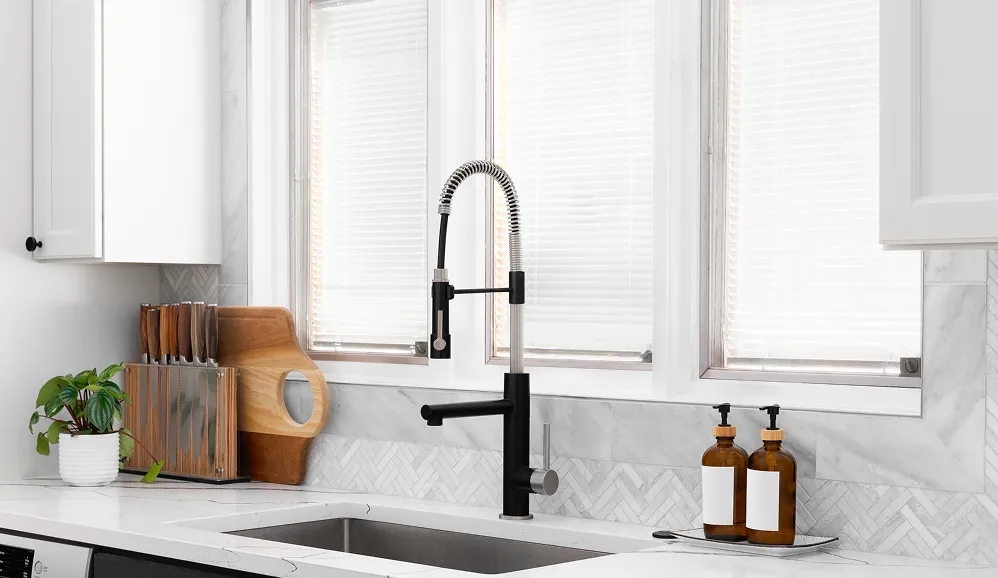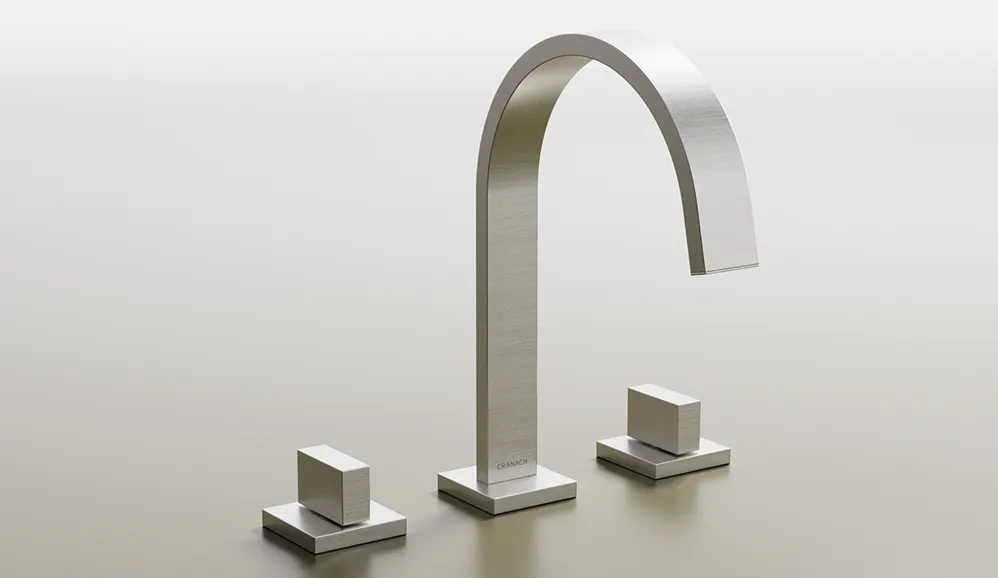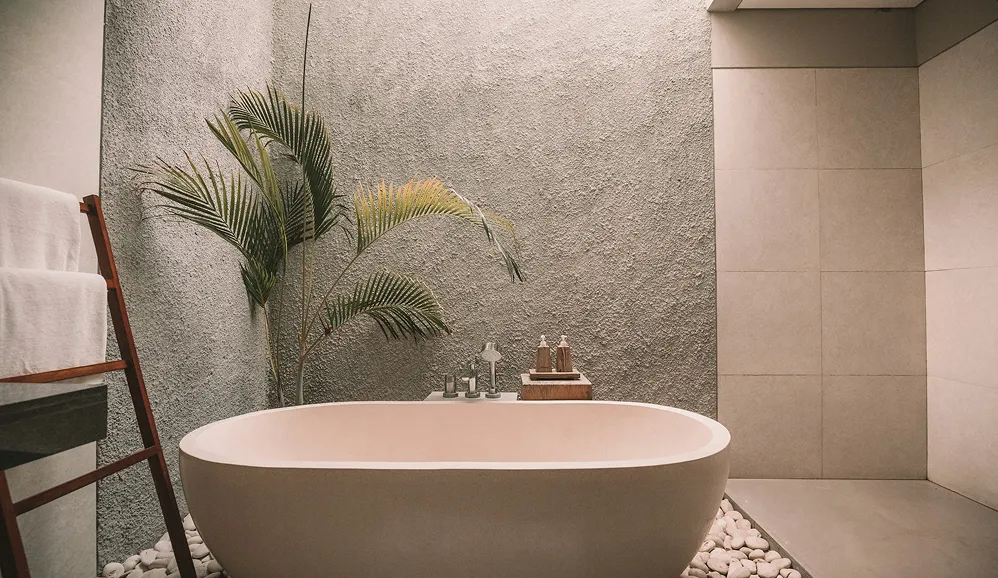So, you’ve just left the studio with fresh ink, and now comes the big question: when is it safe to take that first shower? The excitement is real, but so is the need for caution.
Most tattoo artists will tell you to wait at least 4-6 hours before getting your new tattoo wet, but I’ve always found that giving it a full 24 hours is the sweet spot. This isn’t just arbitrary advice; this initial waiting period is one of the most critical steps in your entire aftercare journey.
The Critical First 24 Hours After Your Tattoo
Think of your brand-new tattoo as a beautiful, meticulously crafted open wound. It needs a moment to breathe and begin its healing process without being disturbed. That first day is all about letting the skin start to close up, forming a natural shield against nasty bacteria and potential infections.
This waiting game is also about protecting the art itself. If you hop in the shower too soon, you risk the water causing some of the ink to “wash out” or become diluted. The last thing you want is a faded or patchy-looking tattoo after all that time and money you’ve invested.
Understanding Your Personal Timeline
How long you actually need to wait often comes down to the type of bandage your artist used. There are two common types, and they make a big difference.
- Traditional Plastic Wrap: This is the old-school method. The wrap usually comes off after just a few hours. Once it’s off, you’ll need to do your first wash, but you still want to be extremely careful with direct water pressure.
- Adhesive “Second Skin” Films: These modern, transparent bandages are a game-changer. They’re designed to stay on for several days, are completely waterproof, and let your skin breathe. If your artist used one of these, you can typically shower much sooner without worrying.
No matter what, your artist’s instructions are golden. They know their work and the best way to care for it. But as a general rule, giving it that initial 24 hours is a safe bet to let the wound begin to seal, which seriously cuts down the risk of infection. You can often find great initial aftercare recommendations on tattoo studio blogs.
Here’s a quick guide on when you can likely shower based on the protective covering your artist applied.
Your Shower Timeline Based on Bandage Type
| Bandage Type | Recommended Waiting Period | Key Consideration |
|---|---|---|
| Second-Skin/Adhesive Film | Can often shower within a few hours | The bandage is waterproof, but avoid soaking the area or letting hot water hit it directly. |
| Traditional Plastic Wrap | Wait 24 hours after the tattoo session | After removing the wrap, you’ll need to wash it gently, but keep showers short and lukewarm. |
| No Bandage (Rare) | Wait at least 24-48 hours | Without a protective barrier, keeping the tattoo dry is paramount to prevent infection. |
Ultimately, the goal is to protect your new ink while keeping it clean.
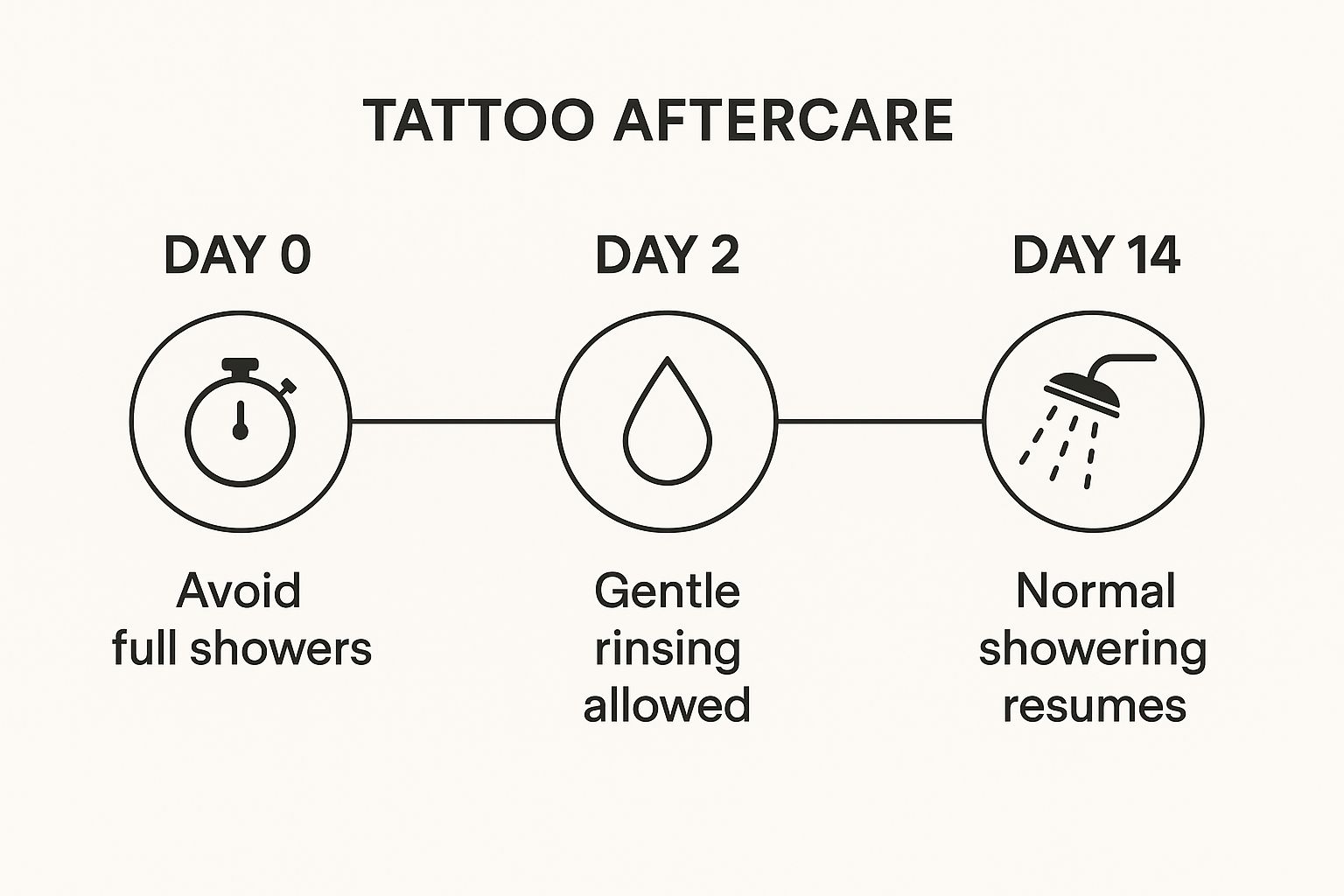
As you can see, patience is key right at the beginning. After that first day, you transition into a gentle cleaning routine, and before you know it—usually after about two weeks—you’ll be back to your normal showering habits.
Key Takeaway: Those first 24 hours are non-negotiable for protecting your investment. Rushing this step can mess with both your skin’s health and how your tattoo looks in the end. A little bit of patience now will pay off with a vibrant, beautifully healed piece of art for years to come.
How to Prepare for Your First Post-Tattoo Shower
Before you even think about turning on the faucet, let’s reframe this. Your first post-tattoo shower isn’t just a shower—it’s a careful, crucial part of the healing process. A little bit of prep work now makes a massive difference in keeping irritation at bay and protecting your new ink. The mission is to get in, get clean, and get out without causing any trouble.
First things first, you need to gather the right gear. It’s a short list, but every item on it is non-negotiable.
- Gentle, Fragrance-Free Soap: Find a mild, liquid antibacterial soap. The key here is that it must be completely free of any fragrances, dyes, or harsh chemicals. Your fresh tattoo is essentially an open wound, and perfumes will only aggravate it.
- Clean Paper Towels: Make sure you have a fresh roll of paper towels sitting within arm’s reach of your shower. Do not even think about using your regular bath towel. Even a clean one can be a breeding ground for bacteria, and its rough texture can easily snag and damage that delicate, healing skin.
That simple setup is genuinely all you need for a successful first wash.
Setting the Right Environment
Once your supplies are lined up, it’s time to handle the water itself. The temperature is everything. Lukewarm water is your absolute best friend here. If the water is too hot, it can open up your pores and potentially cause some of that fresh ink to leach out. Hot water also ramps up blood flow, which can lead to swelling and discomfort.
On the other hand, water that’s too cold can be a shock to the system. You want to find that perfect middle ground—a comfortable, mild temperature that feels gentle. As you get ready, it’s a good idea to read up on how long until you can shower normally after a tattoo to get the full picture of the healing timeline.
Remember this: The point of this first shower isn’t to linger and relax under a hot spray. It’s a targeted, gentle cleanse of a specific area. Keep it quick, and keep it focused.
If your artist put a plastic wrap on you, gently take it off right before you hop in the shower. Sometimes the adhesive can be a bit stubborn. If it’s stuck, just let a little lukewarm water run over it to help it release. Whatever you do, never rip it off. That’s a surefire way to pull up ink and damage the skin underneath.
Showering Safely With a New Tattoo

Now that you’re prepped, it’s time to actually get in the shower. The whole game here is to be quick, gentle, and effective. You’re trying to get your new tattoo clean without driving it crazy, which means you can pretty much forget everything you know about a normal, long, hot shower.
First things first, let’s talk about how you’ll clean it. You’re only going to use your clean fingertips—that’s it. Put the washcloth, sponge, or loofah away. Seriously. Those things are way too abrasive for healing skin, and they can be breeding grounds for bacteria. The last thing you want is to scrape off delicate scabs or mess up the ink.
Squeeze a small blob of your fragrance-free soap into your palm and work up a nice lather. Then, gently apply the suds to your tattoo with light, circular motions. Think of it less like scrubbing and more like a delicate caress. Your only goal is to wash away any dried plasma, old ointment, or a bit of blood from the surface.
Keep It Indirect and Quick
One of the biggest blunders I see people make is letting the shower stream blast directly onto their new ink. Not only can this really sting, but the high pressure can also mess with the ink setting in your skin. You have to be a little strategic with how you stand.
Position your body so the water just runs over the tattoo indirectly. For example, if your new piece is on your forearm, let the water hit your shoulder and flow down your arm. This gives you a gentle rinse without the harsh, direct impact from the showerhead.
Your shower also needs to be short. I mean it. Aim for 5-10 minutes, tops. Spending too much time in a hot, steamy environment can soften the healing skin too much, leaving it soggy and vulnerable to damage.
A global consensus among tattoo professionals suggests waiting at least 24 hours, but some studios now endorse a shorter wait of about 4 hours for a gentle shower. For example, some experts recommend this shorter timeline provided the tattoo isn’t submerged and the water pressure is kept low. You can find more tattoo aftercare guidance from professional tattoo studios.
The Final Steps: Rinse and Pat Dry
After you’ve gently washed the area for a minute or so, it’s rinsing time. Again, let that indirect stream of lukewarm water wash away every last bit of soap. Any soap residue left behind can lead to dryness and irritation, which is exactly what we’re trying to avoid.
Once you step out, this final step is just as important as the rest. Grab a fresh, clean paper towel and gently pat the area dry. I can’t stress “pat” enough. No rubbing, wiping, or scrubbing. Any friction can mess up the delicate skin and the scabs that are crucial for healing. Keep patting until it’s completely dry to the touch.
For a more detailed breakdown of this whole process, you can also check out our complete guide on if you can shower after a tattoo.
Post-Shower Care for Vibrant Long-Term Results
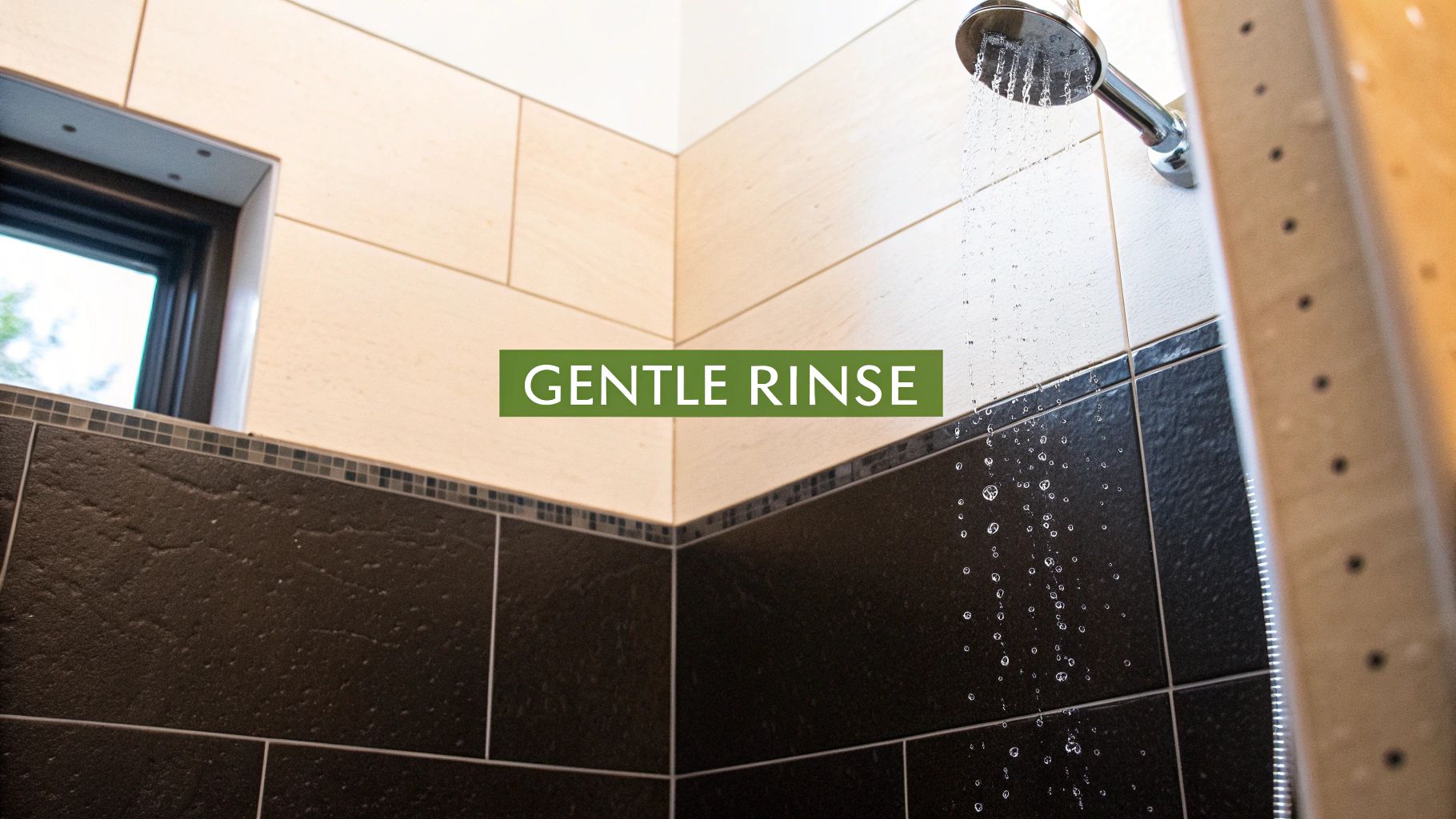
Alright, you’ve made it through that first nerve-wracking shower. But your job isn’t quite over yet. What you do in the moments right after you turn off the water is just as critical for making sure your tattoo’s color stays locked in and your skin heals up perfectly.
This is when aftercare ointment enters the picture, but I can’t stress this enough: less is more.
After you’ve gently patted the area until it’s bone dry, go ahead and apply a super thin, breathable layer of the aftercare lotion your artist recommended. You’re aiming for a slight sheen, not a thick, goopy mess. Think about it this way—your skin needs oxygen to repair itself. If you suffocate it under too much ointment, you can clog your pores, trap nasty bacteria, and actually slow down the whole healing process. The result? A dull, faded tattoo.
The No-Soak Rule: A Must for Long-Term Vibrancy
So, we’ve covered the immediate post-shower routine. Now, let’s talk about a hard and fast rule for the next few weeks. That gentle shower is the only water activity on your schedule for a while. You absolutely have to avoid soaking your new tattoo for at least two to three weeks, or until your artist gives you the official green light.
This isn’t just a friendly suggestion; it’s a non-negotiable step to protect your investment. Submerging healing skin is asking for trouble.
- Baths & Hot Tubs: These are basically warm pools of bacteria. Soaking an open wound like a new tattoo in that water is a direct invitation for a serious infection.
- Swimming Pools: The chlorine and other chemicals floating around in pools are incredibly harsh. They’ll irritate your sensitive skin, dry out your tattoo, and can cause the ink to fade before it even has a chance to settle.
- Oceans & Lakes: Don’t even think about it. Natural bodies of water are teeming with all sorts of microorganisms that can lead to some really unpleasant infections.
Following these aftercare steps diligently is the single best way to guarantee your tattoo stays as bright and sharp as the day you got it. Poor aftercare is the leading cause of faded lines and patchy color.
For a complete rundown, you can dive into our guide that answers the popular question: how long after a tattoo can you shower? Protecting your new art from being submerged is the final, crucial piece of the puzzle for a beautiful, long-lasting tattoo.
Common Showering Mistakes That Can Ruin a New Tattoo
Knowing the right things to do is only half the battle. Honestly, what you don’t do can be the very thing that saves your new art from disaster. Think of this as your field guide to dodging those common, yet costly, showering mistakes that can completely compromise a healing tattoo. Getting this right is what ensures your ink stays vibrant for years to come.
One of the biggest culprits? Scalding hot water. It might feel incredible on a sore muscle, but for fresh ink, it’s a nightmare. Hot water opens up your skin’s pores, which can literally cause the new ink to leach out. The result is a faded, washed-out look before your tattoo even gets a chance to truly settle in.
Spending way too much time in the shower is another major risk. A quick, efficient shower is what you’re aiming for. Prolonged exposure to all that steam and water can oversaturate the healing skin, leading to mushy, heavy scabs that can pull the ink right out when they fall off.
Protecting Your Ink from Irritation and Infection
Another slip-up I see all the time is people grabbing the wrong soap. Harsh, heavily scented body washes are packed with chemicals and fragrances that will severely irritate your sensitive new tattoo. This can cause redness, intense itching, and inflammation—all things you want to avoid. Always, always stick with a gentle, fragrance-free, antibacterial soap.
And please, don’t scrub the area. Your healing tattoo is a delicate wound, not a dirty pan. Using a washcloth, loofah, or even just rubbing aggressively with your hands can tear away the new layers of skin and scabs. This not only damages the design but throws the door wide open for infection.
Proper tattoo aftercare has always been the key to minimizing problems. In fact, data shows that up to 20% of people run into issues like infection or fading, and so much of that is tied directly to getting water exposure wrong.
Finally, watch out for high water pressure. A powerful, direct stream can feel like a tiny sandblaster on a fresh wound, causing real damage. If your shower is a bit too forceful, just angle your body so the water runs over the tattoo indirectly. If you have the opposite problem and need a bit more force, you can check out our guide on how to increase water pressure in your shower.
Frequently Asked Questions About Tattoo Aftercare
Even with the best game plan, questions about your new ink are bound to pop up. It’s completely normal. Let’s walk through some of the most common concerns I hear, so you can handle the healing process like a pro.
One of the biggest questions is about those clear, waterproof bandages, often called ‘second skin.’ Can you really shower with one on? Yes, you can! These things are lifesavers. They’re specifically designed to be waterproof, creating a solid barrier so you can shower without water hitting the fresh tattoo.
A word of caution, though: keep your showers on the shorter and cooler side. Too much steam from a long, hot shower can weaken the adhesive and cause the edges of the bandage to peel up.
Navigating Common Showering Scenarios
What happens if your tattoo accidentally gets soaked? First off, don’t panic. It happens.
The absolute first thing you should do is gently pat the area completely dry with a clean paper towel. No rubbing! Just a gentle, firm patting motion will do. After that, let it air dry for about an hour to be extra safe before you put on a razor-thin layer of your aftercare lotion. The goal is just to get it dry as quickly as possible.
When can you finally stop all the special treatment? You can go back to your normal shower routine once the tattoo is completely done with the peeling and flaking phase. This whole process usually takes about 2 to 3 weeks. Once you hit that milestone, the new skin is much more resilient.
So, when is it really, truly okay to go back to long, hot showers without a second thought? You’ll know it’s time when all the scabbing and peeling are completely gone. The skin over your tattoo might look a bit shiny or waxy—that’s a good sign. It means the new layer of skin has sealed itself and is ready for the real world.
If you want to dive even deeper into this, our guide on when you can shower after getting a tattoo breaks down the entire healing timeline in more detail. Knowing how to handle these little situations gives you the confidence to care for your new art perfectly.
For a shower experience that combines therapeutic benefits with elegant design, explore the premium shower systems from Cranach. Discover our collection and elevate your bathroom at https://cranachhome.com.


